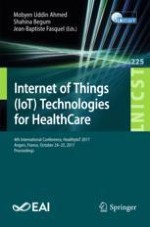This book constitutes the proceedings of the Fourth International Conference on Internet of Things (IoT) Technologies for HealthCare, HealthyIoT 2017, held in Angers, France, in October 2017. The IoT as a set of existing and emerging technologies, notions and services can provide many solutions to delivery of electronic healthcare, patient care, and medical data management. The 17 revised full papers presented were carefully reviewed and selected from 23 submissions. The papers cover topics such as healthcare support for the elderly, real-time monitoring systems, security, safety and communication, smart homes and smart caring environments, intelligent data processing and predictive algorithms in e-Health, emerging e-Health IoT applications, signal processing and analysis , the smartphones as a healthy thing, machine learning and deep learning, and cloud computing.
